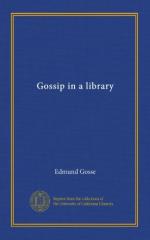discover renowned princesses, nonpareils of beauty,
in imminent danger, and release them. They attack
hordes of deadly pirates, and scatter their bodies
along the shore; and yet, for all their warlike fire
and force, they are as gentle as marmozets in a lady’s
boudoir. They are especially admirable in the
putting forth of sentiments, in glozing over a subtle
difficulty in love, in tying a knot of silk or fastening
a lock of hair to their bonnet. They will steal
into a cabinet so softly that a lady who is seated
there, in a reverie, will not perceive them; they
are so adroit that they will seize a paper on which
she has sketched a couplet, will complete it, pass
away, and she not know whence the poetical miracle
has come. In valour, in courtesy, in magnificence
they have no rival, just as the ladies whom they court
are unique in beauty, in purity, in passion, and in
self-denial. Sometimes they correspond at immense
length; in
Pharamond the letters which pass
between the Princess Hunnimonde and Prince Balamir
would form a small volume by themselves, an easy introduction
to the art of polite letter-writing.
Mlle.
de Scudery actually perceived this, and published
a collection of model correspondence which was culled
bodily from the huge store-house of her own romances,
from
Le Grand Cyrus and
Clelie.
These interchanges of letters were kept up by the
severity of the heroines. It was not thought proper
that the lady should yield her hand until the gentleman
had exhausted the resources of language, and had spent
years of amorous labour on her conquest. When
Roger Boyle, in 1654, published his novel of
Parthenissa,
in four volumes, Dorothy Osborne objected to the ease
with which the hero succeeded; she complains “the
ladies are all so kind they make no sport.”
This particular 1662 translation of Pharamond
appears to be very rare, if not unique. At all
events I find it in none of the bibliographies, nor
has the British Museum Library a copy of it. The
preface is signed J.D., and the version is probably
therefore from the pen of John Davies, who helped
Loveday to finish his enormous translation of Cleopatra
in 1665. In 1677 there came out another version
of Pharamond, by John Phillips, and this is
common enough. Some day, perhaps, these elephantine
old romances may come into fashion again, and we may
obtain a precise list of them. At present no
corner of our literary history is more thoroughly neglected.[1]
[Footnote 1: Since this was written, a French
critic of eminence, M. Jusserand, has made (in The
English Novel in the Time of Shakespeare, 1890)
a delightful contribution to this portion of our literary
history. The earlier part of the last chapter
of that volume may be recommended to all readers curious
about the vogue of the heroic novel. But M. Jusserand
does not happen to mention Pharamond, nor to
cover the exact ground of my little study.]




